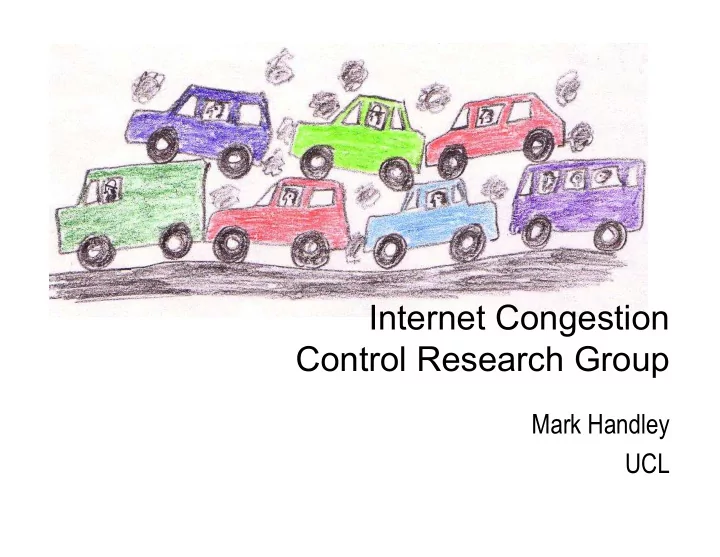

Internet Congestion Control Research Group Mark Handley UCL
Congestion Control The Internet only functions because TCP’s congestion control does an effective job of matching traffic demand to available capacity. TCP’s Window Time (RTTs)
But my network doesn’t have congestion! Maybe. But the end-to-end path should if we’ve done our job right. File transfer: Move x bytes from a to b in time t . Applications work better as t → 0 Realistically, t will never be zero, but our long term goal should be to make it as close to one RTT as possible.
Limitations of AIMD Congestion Control (Additive Increase, Multiplicative Decrease) Very variable transmit rate is fine for bulk-transfer, but hard for real-time traffic. RFC3448: TCP-Friendly Rate Control (TFRC) RFC????: Datagram Congestion Control Protocol (DCCP)
Limitations of AIMD Congestion Control Failure to distinguish congestion loss from corruption loss. Wireless Limited dynamic range.
AIMD: Limited Dynamic Range One loss every half hour, 200ms RTT, 1500bytes/pkt. ⇒ 9000 RTTs increase between losses. ⇒ peak window size = 18000 pkts. ⇒ mean window size = 12000 pkts. ⇒ 18MByte/RTT ⇒ 720Mbit/s. ⇒ Needs a bit-error rate of better than 1 in 10^12. ⇒ Takes a very long time to converge or recover from a burst of loss.
Opportunity We will need to change the congestion control dynamics of the Internet. This presents an opportunity to do it right and solve many additional problems at the same time. Wireless? Smooth throughput for multimedia? Low delay service? DoS resistant? Always easier to solve only the immediate problem.
XCP: eXplicit Control Protocol Katabi, Handley, Rohrs, Sigcomm 2002 Round Trip Time Round Trip Time Congestion Window Congestion Window Feedback Feedback = Feedback + 0.1 packet Congestion Header
XCP: eXplicit Control Protocol Katabi, Handley, Rohrs, Sigcomm 2002 Round Trip Time Congestion Window Feedback = Feedback = + 0.1 packet - 0.3 packet
XCP: eXplicit Control Protocol Katabi, Handley, Rohrs, Sigcomm 2002 Congestion Window = Congestion Window + Feedback Routers compute feedback without any per-flow state
XCP vs. TCP Start Start 40 Flows 40 Flows Stop the Stop the 40 Flows 40 Flows XCP responds quickly to change, gives smooth throughput, low delay, and low loss.
So why isn’t everyone doing it? XCP was intended as a blue-sky idea to see what was possible. Needs all the routers on the path to play. Lots of bits in packet headers. A couple of multiplies and a few adds per packet. Need phase 2: Can we make it economically viable ? Reduce costs without destroying benefits. Enable incremental benefit with incremental deployment.
Plenty of Ideas High-speed TCP (S. Floyd) XCP (Katabi) Scalable TCP (T. Kelly) Re-feedback (Briscoe) FAST (S. Low) VCP (Xia, Subramanian) H-TCP (D. Leith) Work on router buffer sizing (Appenzeller, McKeown, Bic-TCP (I. Rhee) Wischik) Need a forum for evaluation and consensus that includes both researchers and equipment vendors. IETF is not terribly good at this.
Internet Congestion Control Research Group Forum for discussion and evaluation of existing congestion control ideas, with the goal of reaching a consensus on how to move forward. Researchers, vendors, operators needed to be successful. Influence the long-term plans of the IETF. Proposed charter: http://nrg.cs.ucl.ac.uk/mjh/iccrg Mailing list: http://oakham.cs.ucl.ac.uk/mailman/listinfo/iccrg
Recommend
More recommend